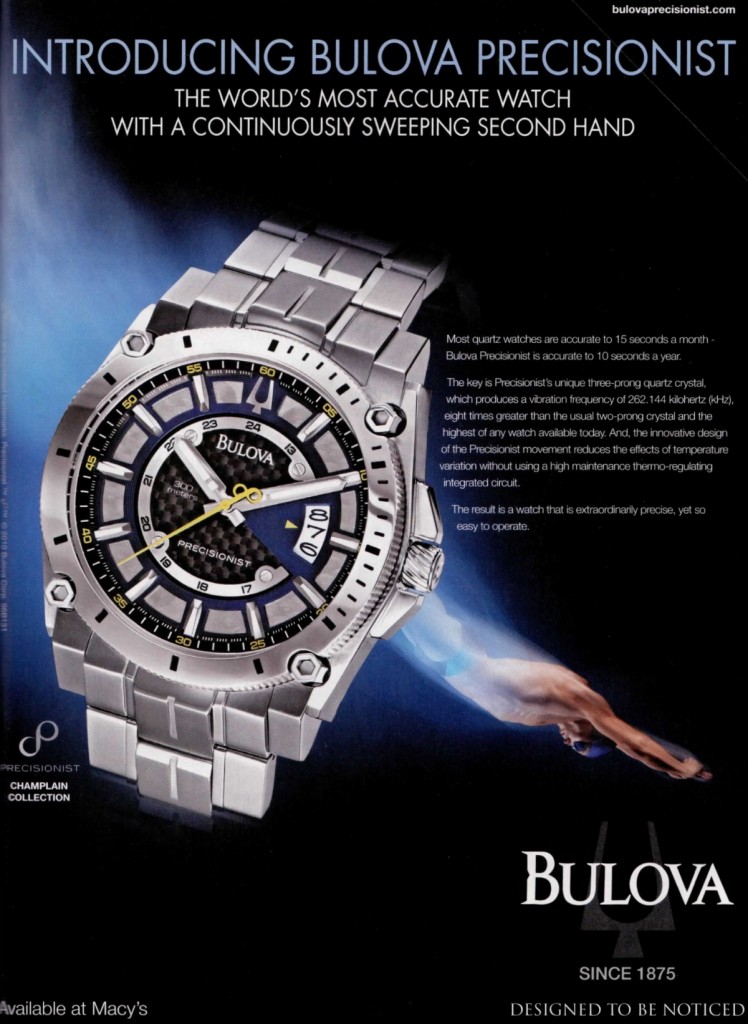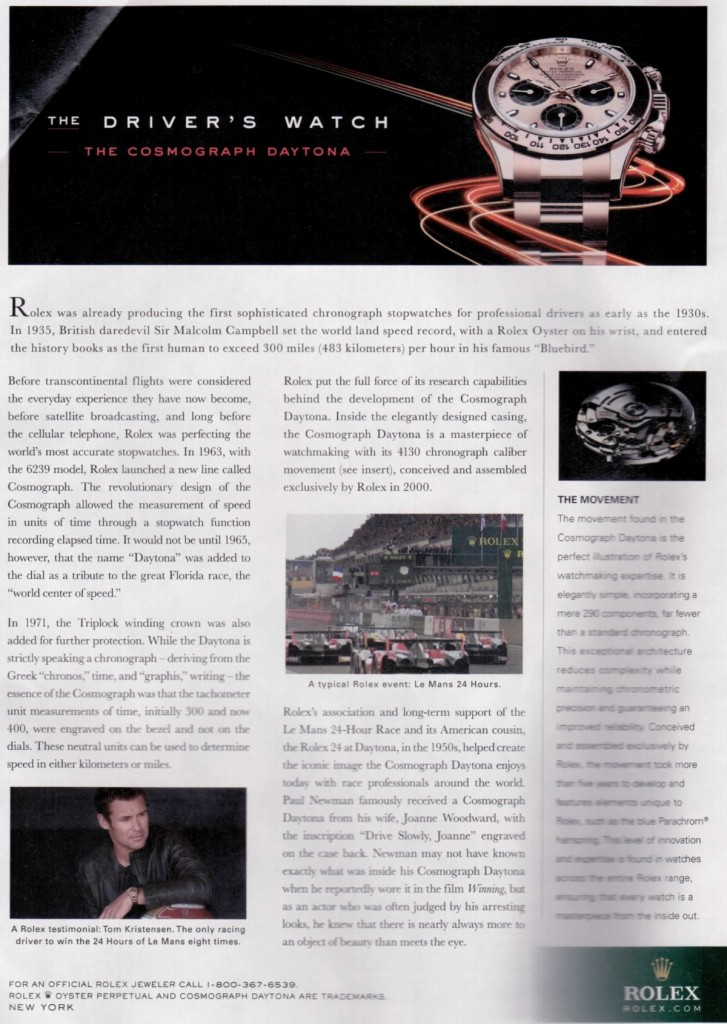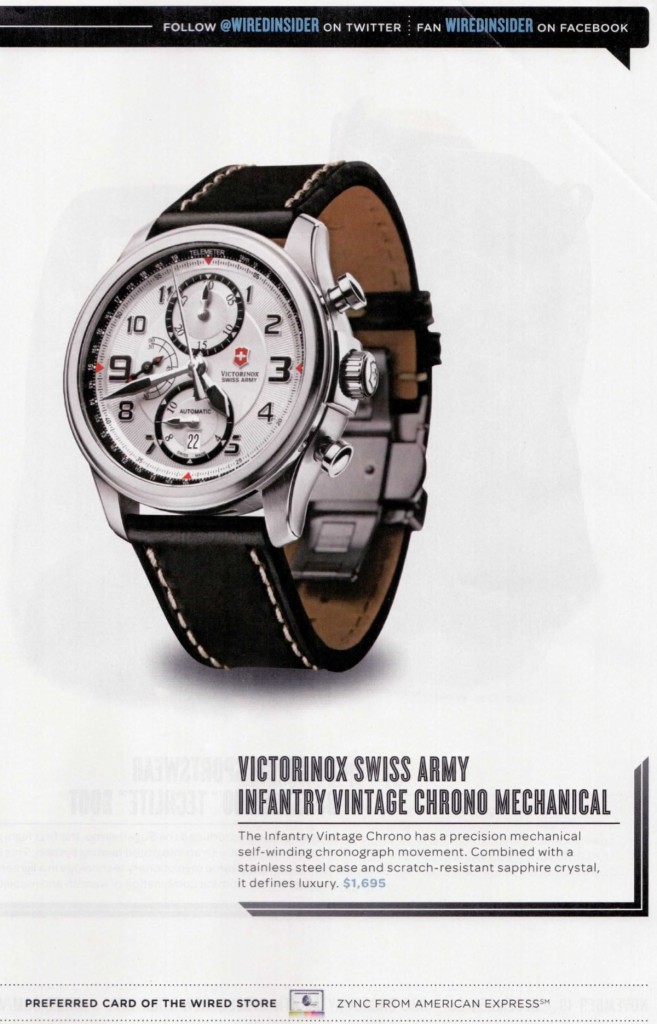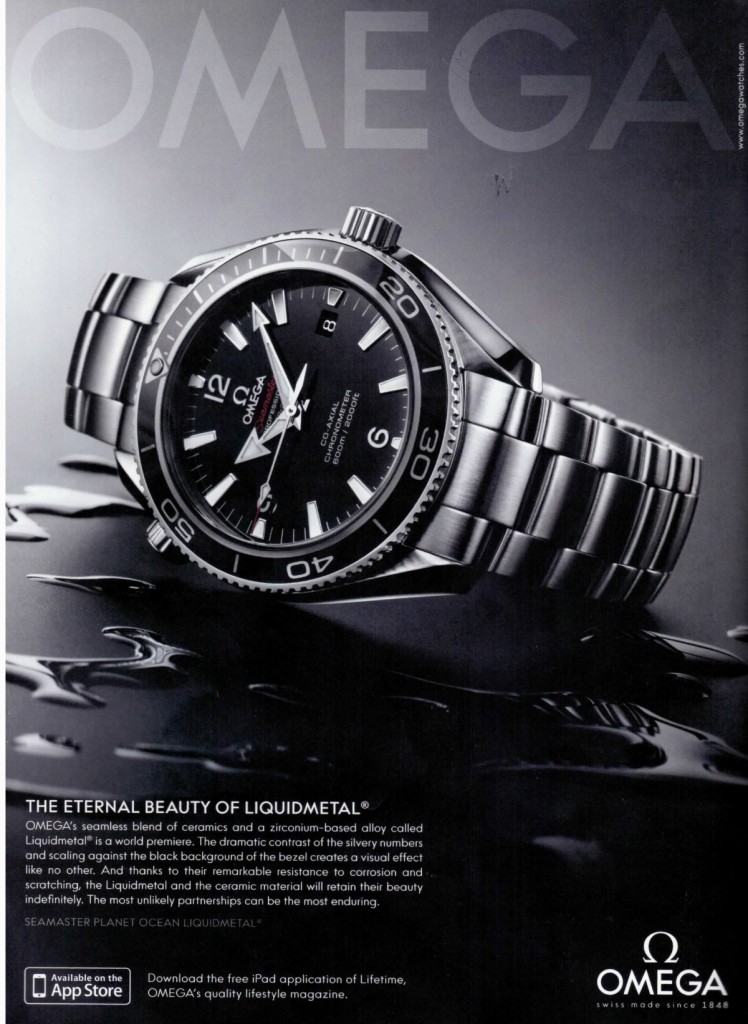
Wired magazine isn’t the only good place for watch brands to advertise, but it definitely is a good placements – an no, they aren’t paying me to say that. Filling up with more and more watch advertisements, the approach many brands have taken with their pages in this magazine for the socialized nerd, can provide important lessons on how to promote watches in this day and age.
I’ve been reading Wired magazine for about a decade now. Not everything single issue, but it is one of the few magazine subscriptions that I have kept. To those not familiar with the magazine, it is an interesting publication. In a pre-Internet world it was a news and trend guide for the tech culture. After the Internet itself became the spot for breaking news, gossip, and breakthroughs, Wired turned into a something more literate. Like a non-fiction New Yorker for computer programmers. Today the quality magazine covers culture, gadgets, entertainment, technology, and science with a lighthearted – often cynically humorous – clever manner.
While I can’t be sure of the target demographic for the publication, the readers are likely to be mostly men, with an above average intelligence, interested in technology, raised by sci-fi, and in high-paying jobs. Pretty much a perfect segment when it comes to being potentially interested in spending more than $100 on a timepiece.
Wired magazine does not really ever write about watches – save for the occasional timepiece they include a gift guide or gadget review. I discuss one specific issue of the magazine for the purposes of this article, which did include two actual editorial mentions of a watch. It was Wired’s December 2010 issue, and a Longines and Timex watch were mentioned in their holiday gift guide with less than 50 words of text each. Usually advertisers like to advertise in places where they might actually get some editorial, but that isn’t the coverage point of Wired. Besides, the publication has a very strong “separation of church and state” between editorial and advertising (as most quality publications have it).
So despite Wired not being a magazine that discussed watches, how and why are brands flocking to it as a power-spot for their products? Wired’s December 2010 issue had 12 pages of watch ads in it. That is pretty good for a magazine for literate computer nerds. That number is also growing – and Wired magazine isn’t cheap to be in. I got to be in a presentation where Wired magazine sold a brand on the value proposition of advertising in its “book.” They make a rather persuasive argument, but it is in their audience and editorial where the value lies (as opposed to merely their sales pitch).
The reason I think you’ll want to read about this topic is because it involves how watch brands can make their promotional messages more interesting to consumers by following the lessons taught by not only Wired magazine, but the watch ads inside of it (as designed most of the time by internal ad departments in brands or external ad agencies). It also helps determine when a magazine/media location might not be such a good place for promotion.

1. Capturing a Captive Audience:
Watch brands are far too used to advertising in fashion magazines. I don’t hide my disdain for these literature-deprived publications, but if they are your thing – well don’t let me stop you from your “look book.” Fashion magazines go under the assumption that their readers can stomach little to no reading. Just sort of inane flipping and skimming. So watch brands got used to designing ads with nothing on them but a picture of a watch, or maybe some model with a watch. Epic failure right there when it comes to selling anything aside from a bit of residual brand recognition after seeing the same ad over and over again. Unless you are in the business of buying watches for models.
Wired’s audience reads what is in the magazine. I often lap up each word, even though I am a product of the “ADD generation” that falls alseep during live theater (or wishes I had a stealthy way to play Nintendo DS). It isn’t that I am a crude ruffian who can’t appreciate fine culture, but rather that I have a small attention span given how much media I grew up consuming. I just need more moving images in front of my face. As such, Wired has developed a way to engage readers with really interesting topics and playful segments. The point here is that because people are highly engaged, the advertisers benefits because people are looking at what is on each page closely. Now that people are paying more attention to your ads, what do you do?
As an example I have here a scanned Bulova Precisionist ad. It offers a clever and succinct explanation of the novel movement the watch contains. It mirrors the magazine’s technical prose so as not to insult the reader’s intelligence and allows them to hold the brand in high esteem (“Bulova knows their stuff and knows how to speak to me!”). This is like the fashion magazine ad, but with actual substance. (click on ad images for larger versions).

2. In the Mood to Read:
Related to the above concept of having an interested audience, is that those people looking at Wired magazine are in the mood to read. It is hard to go from flipping through endless pages of model photo-shoots to actually reading words longer than a brand name and a price. But if you are already in the reading mode, then you’ll be more likely to actually read an ad with words – and words are the key to story telling and message dissemination. The concept of the “advertorial” isn’t by any means new, and people can read these if presented properly. Well-written advertorial pieces are hard to find. Reading a short article in a magazine that stimulated your mind leaves you hungry for more. If you turn the page and see an ad that looks like an article (but not deceptively so), then you have a good chance of getting a reader to take a close look at it. Just make sure it isn’t in translate French.
An example here is from Rolex – in what is likely the best copy text I have ever seen in an ad. This is masterfully written ad language on the Daytona collection.
3. Pictures Aren’t Everything:
Save for one or two ads in the December issue of Wired, all of the watch ads have text and something interesting to say. Fantastic. Although I said this before, it is such an important point I will say it again. People who buy little machines with functions do no want an ad to merely show an image of a watch more Photoshopped than the one of a model on the cover of Glamour.
You have to provide an argument or emotional connect if you are want to convey a message or sell a concept. There are no exceptions, and this must be done with text. On the internet this can also be done with other media such as video or audio.

4. Good Company:
Men love gadgets, and will buy what they can afford. If timepieces are part gadget (or all gadget), it is a good thing. To make a watch more like a gadget, it should be surrounded by quality gadgets and its functional aspects should be emphasized. Gadget guides are a huge part of Wired’s product coverage. Wired even has an entire section on their website dedicated to gadget reviews. Items that get to be part of the “gadget community”enjoy the type of attention gadgets receive from highly engaged readers. Let me put it another way, framing a watch as a gadget is the opposite of framing it as a fashion accessory (though the two aren’t mutually exclusive). Wired magazine’s coverage of gadget in both editorial and advertising will benefit watches that accompany the group.
Wired even takes it a step further with something they called the Wired Store. My understanding is they the magazine rents out a space in New York City for a few months around Christmas. The Wired Store is a showcase for items the brand had features as well as participating advertisers. This is a mecca sport for lovers of the magazine and the items they feature in gift guides. In addition to its interesting stories, Wired does often feed on a man’s desire to learn about (and potentially buy) cool new stuff.
Here, Victorinox Swiss Army opted to be included in the Wired Store. They got a mention in the magazine that was a simple bit of advertorial, as well as the ability to showcase their products in-person – to an audience that might never otherwise see them, and receive some nice gadget street-cred.

5. Feel The Audience:
One of the reasons I like to read Wired is because I feel as though the writers and I not only have similar interests, but also feel the same way on things, as I do. Over time I have come to find that Wired will present thoughtfully written articles on topics that interest me. Often times they are topics that I haven’t read about elsewhere. As such, I have come to give the magazine a great deal of trust and respect. And these are serious topics. Often ones involving the success and tribulation of the largest Internet companies, to how technology is effecting society, as well as advice on how today’s technocrat can live better. Wired might be funny at times, but it isn’t really a “light” publication.
The best advertisers are able to pick up on the tone of the magazine as well as the who is reading it. It is cliche by this point to remind writer to “consider the reader,” but people forget that. When advertising in a specific place, try to remember who you are “speaking to.” The average Wired reader isn’t really interested in how they can look “fabulous.” Certainly they want cool things, but only when the value/price ratio seems satisfactory and there is solid basis for “need.” Wired readers are decision makers, company starters, dedicated gadget junkies, and some of the most critical people on the planet. While it is sometimes wise to tell men how they “need a watch if they want to be considered a distinguished individual,” in Wired the message a good advertiser delivers is often “do you want a tried and true tool that will improve your life and look pretty decent in the process?”
There are no blingy watches being advertised in Wired. Nothing with diamonds, or those many bright colors. The only gold watch is a Rolex Daytona. Instead, the watches being shown are mostly in silver, black, and white tones. Masculine, but not over the top. Relaxed, confident timepieces that allude to what the wearer should feel like wearing them. That doesn’t mean the watches are cheap, but rather that those brands understand Wired readers want quality, lasting tools. Not this season’s hot nightclub wrist candy.
The Omega Seamaster watch ad on the back page of the magazine illustrates that point well. It is an ad for Omega’s new Seamaster that the brand is testing with a Liquid Metal bezel. The ad text goes in to relatively complex detail on what Liquid Metal is, and how it will keep the bezel looking new for years to come. An exact (and simple) message targeted to the reader.
I am not saying that Wired is the only magazine to have these ads, or that it is the only magazine good enough to advertise watches in. But as a fan myself, I was impressed at the value they can provide to brands (that can afford them) given their quality editorial and distinct (but wide) reader niche. These simple lessons are useful to most brands in at least some areas of their marketing and communication.
